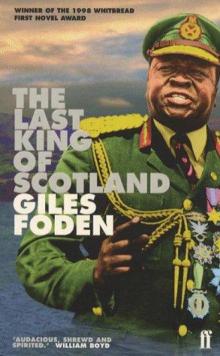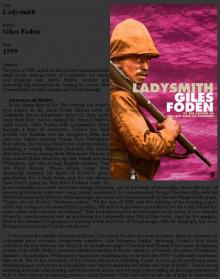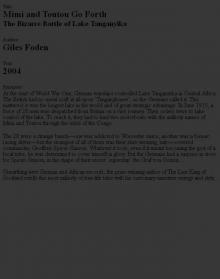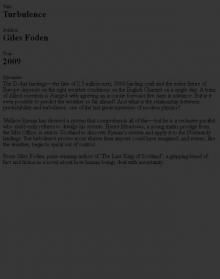- Home
- Giles Foden
2004 - Mimi and Toutou Go Forth Page 23
2004 - Mimi and Toutou Go Forth Read online
Page 23
‘Their language is very old,’ said Hamidu, a researcher into chimpanzees who had hitched a lift in my boat on the return journey. ‘They came here long ago, before the railway was built. They enslaved people for the Arabs, and then they worked for the Germans and the British.’ He revealed that his grandfather was Holo-holo. ‘Now they have been absorbed into the Tongwe. There are very few pure Holo-holo left. They were very good fighters. In those days if you did not move off your lands when the Holo-holo came, he would kill you. But if you obeyed them and left the land they would not kill you.’
Have any words of Holo-holo entered into Tongwe? ‘Only one I know. It is msampwe. Prisoner.’
We made our way back to camp. Mist sat on Mount Kungwe above. I spotted a refugee camp on the shoreline, its tents of green polythene torn and napping. I went in to investigate, but some soldiers waved me away. Through my binoculars I watched a tall naked man with a stomach like a drum stoop down to the water, cupping his hand to drink.
The following day I travelled to Kalilani, a village full of Congolese refugees from the 1960s. It was noticeably poorer than the Tongwe villages nearby. Here, I had been told, lived one of the last pure Holo-holo along this side of the lake. His name was Seif Rusesa and he came out to greet me, smiling, the sun gleaming on the beads of his Muslim skullcap.
Now about 68 (he couldn’t remember the exact year of his birth), he had paddled over here from the Congo in 1964. His wife, four children and a chicken came with him in the canoe. We sat on stools in the middle of the village and I asked him why he had left the Congo.
‘There was too much fighting. There were European mercenaries there.’
Seif and his family had set off in the morning and arrived at three the following afternoon. There was no village before he came. Now there were about 500 people, mainly Congolese from the Bembe tribe. He speaks to them in Swahili or their own language. He doesn’t speak Holo-holo any more, and has forgotten most of it.
Was he always a Muslim? ‘No. On the other side we Holo-holo worshipped a spirit called Migabo. Then they became either Christian or Muslim. But I am the only Holo-holo left now.’
I remembered that the Migabo were the ancestral spirits of twins who interceded with Mkungwe on behalf of humans. Round us, children were beginning to gather, draping themselves over an old tree trunk. I pressed him on the Holo-holo religion, even though it made him uncomfortable to talk about it.
‘There was a hut where the waganga [witch doctors] would call down the spirit. They would smear white soil on their face. Like suntan cream you whites put. They were members of a spirit society and you went inside the hut to see him, and they bring the spirit down into you.’
The children around us were terrified; he told them that he had seen this ceremony with his own eyes as a child. ‘They don’t know any of these stories,’ he explained. ‘They cannot capture it any more. In the old days they would sit round and listen.’ I suddenly realised that in coming here to research the oral tradition, I was encouraging a rare demonstration of it.
I asked Seif if he could remember anything about the ceremony which brought down the spirit. Could he show it to me? At first he was reluctant, putting his head in his hands and saying it hurt to remember. Then he sent one of his wives to fetch a cloth. He put the cloth over his head and started to shake, putting out his arms.
‘They shook gourds with stones inside,’ he said through the cloth, ‘and they sang.’
He began to sing in Holo-holo, dredging ancient words from his memory: ‘Nangisane babo, nangisane kulin-gamira, nanjatakulugo…’It was the spirit-possession song of the Migabo cult, and hearing it chilled me a little, though the translation was innocuous enough. ‘I am coming to you, I am coming to see, I am going home…’
Why call down this nzimu, this spirit? Seif pulled on his fingers, making the list. ‘It is to make a sick person better, to explain something that has happened in the past, or to say what is going to happen in the future. And it is also to kill somebody.’
I wrote down Self’s answers as carefully as he had given them to me. As I was doing so, a motor boat buzzed across the bay. Like Spicer 90-odd years before, I took out my binoculars and looked. It was one of the boats from the chimpanzee reserve, donated by the Frankfurt Zoological Society, whose logo was printed on the side.
I thanked Seif for his help and tried to give him some money for his efforts. He refused it, pointing at my binoculars. ‘When you come back, bring me some of those.’
§
In June 1919 Spicer was a Royal Navy delegate at the Paris Peace Conference, probably on account of his skill in speaking French. The following month he organised an International Hydrographic Conference in London, for which he was also official translator. Those attending included Commander Yamaguchi of the Japanese Navy and Lieutenant-Commander de Vasconcellos of the Brazilian Navy. They were joined by British dignitaries such as Sir William Napier Shaw, Director of the Meteorological Office, and Sir Francis Younghusband, the explorer of Tibet. To entertain the delegates, Spicer took them to a performance of Chu Chin Chow—a spectacular musical based on the story of Ali Baba and the Forty Thieves.
Briefly Assistant Director of Naval Intelligence, Spicer later became the first Secretary General of the International Hydrographic Bureau in Monte Carlo, an organisation dedicated to the sharing of technical information about the world’s oceans. A note in the autobiography of Baroness Orczy, the Hungarian-born novelist who wrote The Scarlet Pimpernel (1905), mentions Spicer in glowing terms and also a lecture he gave to the town’s Societe des Conferences about his mission to Lake Tanganyika.
The Baroness clearly enjoyed Spicer’s talk. ‘He showed us some wonderful magic-lantern slides that he had taken and developed himself.’ Later in the season, the Baroness herself tackled the subject of literary frauds in a lecture (Chatterton and Macpherson and suchlike). Had her friend Spicer—who wore a chestful of medals and heavy ceremonial gold epaulettes on such occasions—told the whole truth in his lectures? It seems unlikely. For one thing Magee, the journalist and ‘Petty Officer Writer’, had taken the pictures, not Spicer. Perhaps it didn’t matter. Within the glittering confines of the British expatriate community on the Côte d’Azur, Spicer could live out his fantasies with all the props.
In 1937, as the storm clouds of another war approached, the man who had been Bwana Chifunga-Tumbo resigned his post in Monaco. Settling in Canada, Spicer lived in Courtenay, British Columbia, until his death on 29 January 1947, at the age of 71. He was survived by his wife, Amy.
His elder brother Theodore, who was interned by the Gestapo in France during the Second World War, lived much longer. Moving to the United States in 1946, he achieved some celebrity with his work as a portrait medallist. By the time he died at Coconut Grove in Florida in 1959, many prominent figures on both sides of the Atlantic had sat for him, including Wilbur Wright, James Joyce, Joseph Conrad, Winston Churchill and several US presidents. Theodore had made a medal of Geoffrey in 1903 (twelve years before the expedition to Tanganyika). It is interesting, to say the least, that both brothers were consumed with the idea of the heroic, for that is certainly the quality that Theodore’s medals strive to express. Perhaps it all goes back to those gold sovereigns their father dealt in.
The Graf van Götzen had been twice sunk and twice raised by the time Bwana Chifunga-Tumbo died. The Germans never got the chance to come back and raise her. After the First World War, it was the Belgians who salvaged the Götzen and towed her to Kigoma harbour—where she sank again at her moorings during a storm not long afterwards. In 1921, back in the job of First Lord of the Admiralty in the post-war Liberal government, Winston Churchill ordered that the Götzen be raised once more and reconditioned under the auspices of Britain’s new League of Nations mandate territory of Tanganyika. The long period of immersion in water had less effect than might be expected. Once Zimmer’s grease had been removed, the steam cocks and engine parts shone brightly. Astonishingly little damage had
been sustained. On Monday 16 May 1927 she sailed again, registered as the Liemba: the name given to Lake Tanganyika in Livingstone’s time. A luncheon of seven or eight courses was served to the dignitaries on board, with champagne and liqueurs.
Fifi⁄Kingani also survived after the War, though not for so long as the Götzen. Known as ‘the government steam launch’, she maintained a passenger and cargo service between Kigoma and the southern ports on behalf of the Marine Department of the Tanganyika government. The fare in 1922 was 2½ cents per mile for Africans, 9 cents per mile for Europeans. In 1924, deemed unseaworthy, she was towed three miles out of Kigoma and sunk in 200 feet of water.
After Tanzanian independence (1961), the Liemba fell into disrepair. It became the obsession of a hard-drinking Irish engineer called Patrick Dougherty who spent years working on its hull and engines. He was rather like the character played by Bogart in The African Queen. There was a great celebration in November 1976 when Dougherty finally got the ship running again. Nowadays the Liemba, which was converted from steam to diesel in 1978, is the lifeline of the lake, binding poverty-stricken communities together. In the harvest months, when people are transporting crops to market, it carries up to 1,000 passengers.
As for Mimi and Toutou, nobody knows what happened to them. On my return to Kigoma I received permission to look for them in the military docks, where the old German railway still comes right up to the quay. There were plenty of iron hulks there and a few old wooden boats, but I didn’t think any of them could be Mimi or Toutou. Their mahogany hulls would surely have rotted away by now.
But just as I was leaving, Musa Hathemani, the chief executive of the port authority, called me in to his office. He had once been told that the wreck of HMS Toutou (he called her ‘Tow-Tow’ like the ratings on the expedition) was submerged off a village called Kabalan-gabo. I took a whaler taxi there, thinking it was too good to be true. This could be the gold I had been looking for—a physical historical connection to the Naval Africa Expedition…
A fisherman directed me to an area of pea-green water about 20 feet offshore. Stripping off, I dived and swam as hard as I could. But it was too murky to see and I could not stay down. In fact, I got nowhere near the bottom. I came up spluttering and staggered back to the shore. Pulling on my T-shirt, I quizzed the villagers, who had lined up along the beach to watch my ridiculous antics. They had never heard of Toutou. But yes, a boat could be seen there until a few years ago—yes it was a boat from the Great War between the Germans and the English.
Apparently some part of the superstructure used to stick up, but it was now covered by sand. Whether it had belonged to Ujerumani or Uingereza, they did not know.
It was just the boat of some white men who had fought near here, long ago.
ACKNOWLEDGEMENTS
This is a fugitive tale, and I have employed a large number of sources in pursuing it. By far the most important of these is Peter Shankland’s marvellous The Phantom Flotilla (1968). I hope that I have been able to add usefully to his account. I would also like to recognise the generous assistance of the individuals who have aided me during the writing of this book, in particular Rowland White (whose idea it was), Derek Johns, Ian Pindar, Steve Caplin, who compiled the ‘Catalogue of Vessels’, Sarah Day, Elisabeth Merriman, Katy Nicholson, and Terence McNamee of the Royal United Services Institute. Imtiaz and Sextus from Kigoma Hilltop were of invaluable help on a difficult journey in Tanzania. Brian Furner of the London School and Hospital of Tropical Medicine and Andrew Crymble of the Royal Society of Medicine assisted me in tracking down an obituary of Dr Hanschell. Thanks are also due to Ian Jack of Granta and Sarah Spankie of Conde Nast Traveller, Sandra Piscedda of Murenga Ridgebacks, and Linda Costa. The book would be a much lesser thing without its illustrations by Matilda Hunt. The author and publisher are grateful to the following for permission to reproduce copyright material: quotations from The Phantom Flotilla by Peter Shankland © Peter Shankland (1968) reproduced by kind permission of Harper-Collins Publishers Ltd; quotations from The Great War in Africa (1914–18) by Byron Farwell © Byron Farwell (1987) reproduced by kind permission of Penguin Books Ltd; quotations from ‘The Operations on Lake Tanganyika in 1915’ by Geoffrey Spicer-Simson (RUSI Journal, Vol. 79, November 1934) reproduced by kind permission of the Royal United Services Institute; quotations from An Open Book by John Huston © John Huston (1980) reproduced by kind permission of Da Capo Press; quotations from Remote People by Evelyn Waugh © Evelyn Waugh Settlement (1931) reproduced by kind permission of PFD (www.pfd.co.uk) on behalf of the Beneficiaries of the Evelyn Waugh Settlement; quotations from London to Ladysmith via Pretoria by Winston Churchill © Winston Churchill (1900), reproduced by kind permission of Curtis Brown Ltd, London, on behalf of the Estate of Sir Winston Churchill; quotations from Die lange Fahrtder Graf Götzen © ECO Media TV-Produktion (2001) reproduced by kind permission of Stephan Lamby. The endpaper photograph of Spicer semaphoring from the Dix-Tonne to Mimi and Toutou, taken by Frank Magee, is reproduced by kind permission of the National Geographical Image Collection.

 The Last King of Scotland (1998)
The Last King of Scotland (1998) Zanzibar
Zanzibar Turbulence
Turbulence The Last King of Scotland
The Last King of Scotland 1999 - Ladysmith
1999 - Ladysmith 2004 - Mimi and Toutou Go Forth
2004 - Mimi and Toutou Go Forth 2009 - Turbulence
2009 - Turbulence